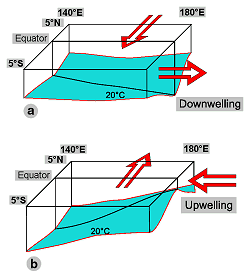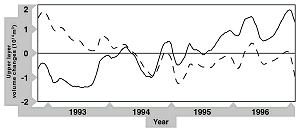Assimilating TOPEX/POSEIDON data to better understand Warm Pool replenishment and depletion in the western Tropical Pacific ocean
L. Gourdeau (IRD, France), T. Delcroix (IRD, Nouvelle Calédonie), J. Verron (LEGI, France)
The study of mass variations in the Warm Pool is a key aspect of existing theories about the El Niño Southern Oscillation (ENSO). To attempt to improve our understanding of the mechanisms underlying such variations, we assimilated TOPEX/POSEIDON altimetric data in a primitive equation model of the tropical Pacific Ocean covering October 1992 to October 1996. The fields of this assimilated model clearly show how zonal and meridional transports affect variations in the volume of the Warm Pool.
Oceanographic studies of the tropical Pacific by teams from IRD and LEGOS in Toulouse, France, and in Nouméa, New Caledonia, in collaboration with LEGI in Grenoble, France, and US teams at NASA/GSFC, have focused on analyzing and understanding ENSO mechanisms and Warm Pool dynamics. These studies implemented a modeling/assimilation system that uses all available observations, particularly altimetric data, to obtain a wider picture integrating all theoretical and observational information about the ocean system. We present here the first results of our work, which show the benefits of assimilating TOPEX/POSEIDON (T/P) data in a primitive equation model to study the dynamics of the Warm Pool, which plays a key role in ENSO.
Assimilation
The assimilation method is based on a degraded version of the SEEK filter [Pham et al., 1998] in which the reduced order basis is fixed. The dynamic model [Gent & Cane, 1989] is a reduced-gravity primitive equation model, with a high horizontal resolution. Only T/P sea level anomalies (SLAs) are assimilated under the satellite ground tracks, with a time step of three days. The method performs well in twin experiments and all model variables are constrained by surface observations [Verron et al., 1999].
We used four years of T/P data (1992-96) to validate model simulations in assimilation mode by comparing against independent observations from TAO moorings [Hayes et al., 1991] and the XBT operational network. The results, described in Gourdeau et al. [1999], show that assimilation noticeably improved the model’s performance. In terms of SLA, the comparison with TAO moorings yields a mean correlation of 0.66 and an rms difference of 4.4 cm for the assimilation model, and 0.49 and 5.5 cm respectively for the model without assimilation. Data assimilation is particularly useful because it allows us to constrain subsurface structures. For example, assimilation improves simulation of the depth of the 20°C isotherm (characteristic of the thermocline): the rms difference calculated for the TAO moorings is 28 m with assimilation and 35 m without assimilation. In terms of temperature, a statistical study using XBT data shows that errors in mean fields and model variability were reduced almost by half. The restricted number of observations from the six TAO moorings along the Equator makes it harder to validate the model’s velocity fields. However, the correlation is noticeably better in and above the equatorial subcurrent (see Figure 1).
Warm Pool evolution
We used the assimilated fields, already shown to closely match the "sea truth", to study the mechanisms behind depletion and replenishment of the Warm Pool between October 1992 and October 1996. The Warm Pool has been of interest in understanding ENSO ever since the pioneering work of Wyrtky [1985] regarding the "build up" concept. The period studied was marked by two relatively weak warm El Niño events (1993, 1994-1995) and one cold La Niña event (1996). The Warm Pool is defined here by waters at above 20°C inside a box bounded by 140°E-180°E longitude and 5°N-5°S latitude. Figure 2a (solid line) shows the evolution over time of the Warm Pool volume calculated using the temperature fields. We observe negative volume anomalies corresponding to eastward transports of the Warm Pool during the El Niño events of 1993 and 1994-95, and positive volume anomalies between the two warm events and during the 1996 La Niña corresponding to westward transports of the Warm Pool. These results agree with those obtained by Delcroix et al. [1998]. The advantage of our model is that we obtain a complete velocity field and that we can thus derive a new estimate of Warm Pool variations from zonal and meridional transports across the box (Figure 2b). Transports are positive (negative) where the flow is entering (leaving) the box. A comparison of these two estimates shows that: a) variations derived from temperatures are in phase with those estimated from the zonal transport; b) out of phase with those estimated from the meridional transport; and c) the amplitude of variations estimated from temperatures are a factor of three lower than those derived from zonal or meridional transports. Conversely, the sum of zonal and meridional transports completely balances the variations derived from temperatures (Figure 2a, dotted line). These same calculations performed using the free model (i.e., no assimilation) yield relatively different results (Figure 3), since the correlation between volume variations derived from temperatures and velocity fields is –0.3, against 0.73 where data assimilation is used.
Conclusion
The assimilation method, based on the SEEK filter, appears particularly well suited to propagating subsurface altimetric data onto the model's temperature and velocity variables. The study of Warm Pool mass variations clearly shows that zonal and meridional transports have an equal impact. Equatorial Kelvin and Rossby waves have been identified as driving the mechanisms that underlie zonal currents [Delcroix et al., 1998], but those responsible for meridional currents are still being studied because they could be a major factor explaining ENSO dynamics. We show that the mass deficit during El Niño and the mass accumulation during La Niña are due mainly to time-integrated mass transports across the eastern and northern boundaries. The reversal of zonal and meridional transports between El Niño and La Niña is also worth noting (Figure 4). The corresponding sea level variations (of the order of 10 to 20 cm), translated via the model and data assimilation into subsurface currents, allow us to estimate global mass transports (of the order of 1014 m3).

Figure 4: Illustration of the main mechanisms underlying Warm Pool mass variations in contrasting conditions during the 1993 El Niño (top) and the 1996 La Niña (bottom).
References:
- Delcroix, T., B. Dewitte, Y. Dupenhoat, F. Masia, J. Picaut, 1998: Equatorial waves and Warm Pool transports during the 1992-97 ENSO events. J. Geophys. Res. (submitted).
- Gent, P.R., M.A. Cane, 1989: A reduced-gravity primitive equation model of the upper equatorial ocean. J. of Comput. Physics, 81 (2), 444-480.
- Gourdeau, L., J. Verron, T. Delcroix, A.J. Busalacchi, R. Murtugudde, 1999: Assimilation of TOPEX/POSEIDON altimetric data in a primitive equation model of the tropical Pacific Ocean: 1992 - 1996. J. of Geophys. Res. (submitted).
- Hayes, S.P., L.J. Mangum, J. Picaut, A. Sumi, K. Takeuchi, 1991: TOGA-TAO: A moored array for real-time measurements in the tropical Pacific Ocean. Bull. Am. Meteorol. Soc., 72, 339-347.
- Pham D.T., J. Verron, M.C. Roubaud, 1998: A singular evolutive extended Kalman filter for data assimilation in oceanography. J. of Marine Systems, 16, 3-4, 323-340.
- Verron J., L. Gourdeau, D.T. Pham, R. Murtugudde, A.J. Busalacchi, 1999: An extended Kalman filter to assimilate satellite altimeter data into a non-linear numerical model of the tropical Pacific Ocean: method and validation, J. Geophys. Res., 104, 5441-5458.
- Wyrtki K. , 1985: Water transports in the Pacific and the genesis of El Niño cycles, J. Geophys. Res., 90, 7129-7132.




















